Getting on top of feathertop Rhodes grass: an increasing weed in the central west of New South Wales
Author: Rob Long (B&W Rural Moree) | Date: 17 Mar 2016
Background
Why has feathertop Rhodes (FTR) grass (Chloris virgata) become such a major problem in recent years in central west New South Wales (NSW)? To understand we need to look at the weather in recent summers, the ecology of FTR and recent developments in the farming systems. FTR has acquired a tolerance to glyphosate, especially once seedlings develop beyond the early tillering stage. The heavy reliance on glyphosate in no-till farming systems has controlled other weeds very effectively, but not FTR, leaving space for it to flourish, a classic example of species shift.
FTR was a minor weed when many of the companies submitted their data for herbicide registrations, and therefore, it is not on those labels. The only herbicides registered specifically for Feathertop Rhodes control are propaquizafop (Shogun®), butroxydim (e.g. Factor®), clethodim (e.g. Select® Xtra) as knockdowns, Isoxaflutole (e.g. Balance®) as a fallow residual and Arsenal® Xpress (for non-crop uses only). Paraquat has a registration for grass control in general. Haloxyfop has a minor use permitɸ in Queensland for pre plant knockdown prior to mung beans only. Glyphosate is not registered for use on FTR. Label changes have not kept pace with the recent rate of spread and localised impact of the weed.
ɸPermit number 12941 only valid until 31 August 2016
Rainfall – comparing Barellan with Moree
Southern NSW has had a series of wet summers in recent years. Using November to March to represent the period of summer fallow, in the last five years Barellan had 63 per cent more rain during that period than its long term mean (Figure 1). Interestingly Moree for that same period has had just two per cent above mean rainfall (Figure 2). Those wetter summers in central and southern NSW created the opportunity for multiple germinations of Feathertop Rhodes grass. Is this period of wet summers a symptom of climate change or just a series of random major rain events?
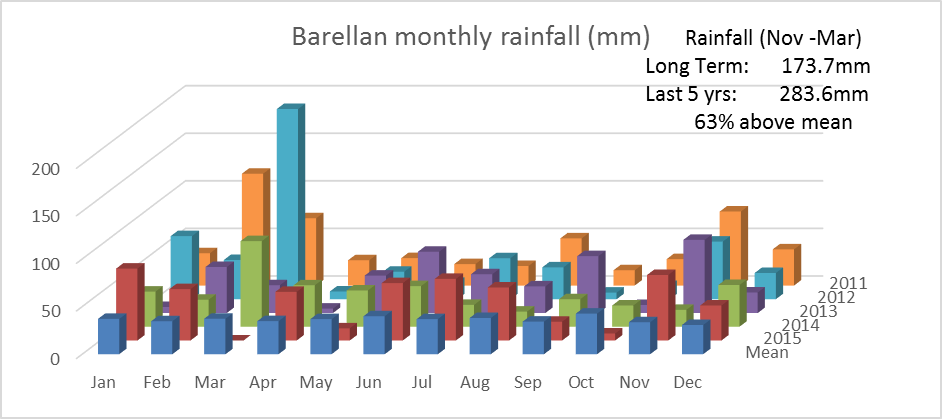
Figure 1: Monthly rainfall for Barellan 2011-2015 (Source: Bureau of Meteorology).
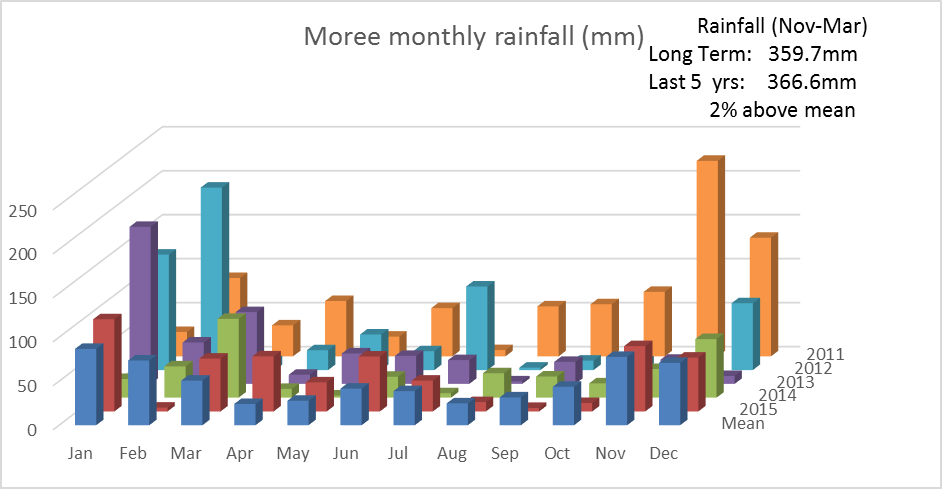
Figure 2: Monthly rainfall for Moree 2011-2015 (Source: Bureau of Meteorology).
Ecology of the plant
Feathertop Rhodes (FTR) grass (Chloris virgata) is a tufted annual grass capable of growing one metre tall with branches capable of rooting at the joints. Seedlings are erect and have a flattened appearance. Seed heads have 7-19mm panicles with 3-9mm long seeds including stiff white hairs and awns, giving it its feathery appearance.
The light fluffy seed can be dispersed by wind and carried by stock. Invasion is often from outside the farm boundary, for example, via roadsides or railway lines. Then the weed thrives in a no-till glyphosate dominant system. FTR is a very serious problem in central Queensland, with a sub-tropical climate where it germinates all year round. Sorghum is the crop in northern NSW and Queensland (Qld) that provides the greatest challenge for FTR control. In NSW optimal germinations occur between spring and autumn; the plant prefers temperatures above 25°C. In a warm wet spring germinations can occur under the growing winter crop prior to harvest, and be semi mature before any knockdown control is possible.
Seed viability is relatively short lived (7-12 months), irrespective of seed burial depth. The seed also has relatively poor emergence. Over a 12 month period, 47 per cent of seed buried near the surface germinates, compared with 5 per cent at 5cm and zero per cent at 10cm depths (Figure 3). This is a weak point of its ecology and should be exploited in any integrated weed management (IWM) control program.
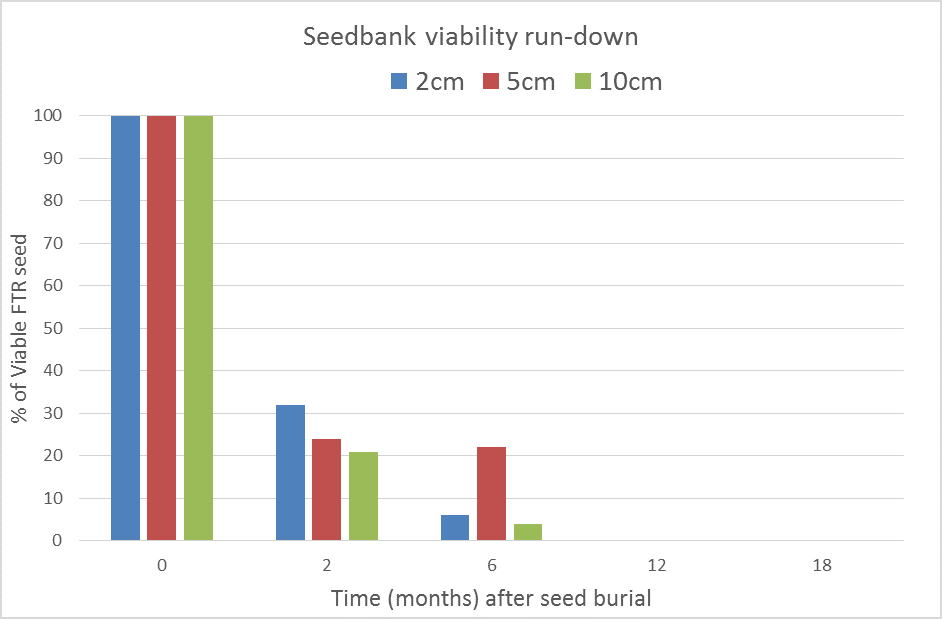
Figure 3: The decline in seed viability of FTR over time at three different burial depths (Source: DAF QLD).
FTR ecological strengths
- High fecundity (up to 6000seeds/plant)
- Fast growth rate, seedling to seed in six weeks
- Responds quickly to small rainfall events
- Ground creeper – nodes develop roots
- Knockdown herbicides are quite ineffective once tillered or stressed
FTR ecological weaknesses
- Short lived seed
- Shallow rooted in dry seasons
- Poor emergence from > 5cm
Herbicide control options
Knockdown herbicides in fallow
Glyphosate (Group M) ɸ
Glyphosate shows variable results on FTR seedlings and loses efficacy as the plant tillers and matures (Table 1).
While glyphosate may provide satisfactory control on fresh seedlings, double knocking with Paraquat is necessary to achieve consistently good results (Figure 5).
ɸFTR grass not on label.
Group A products
Propaquizafop (Shogun®), as of December 2015, has a registration for summer fallow and prior to sowing summer and winter crops on 2 leaf – 3 tiller FTR @ 500-900ml/ha + adjuvant, followed by an application of minimum 1.6 L/ha paraquat 7-14 days later. The label states ‘Do not plant cereal crops for a period of 28 days after application of Shogun®’.
Clethodim® and Butroxydim® are registered in various summer crops for FTR.
Haloxyfop (Verdict 520 @ 150-300ml/ha) has a minor use permit (APVMA permit 12941) in Queensland for pre plant knockdown prior to mung beans only, with the proviso it is followed by a minimum rate of 1.6L/ha Paraquat double knock within 7-14 days of the first application.
Group A products are much more effective on young, fresh grasses. This is important given summer grass weeds can stress quickly when conditions turn hot and dry.
Trial data has shown the fops to have better efficacy than the dims.
Herbicide resistance is a major concern for the Group A products, their mode of action makes them the most prone of all herbicides. The catch-cry ‘six shots and its gone!’ was coined by the Central Qld Grower Solution group and should serve as a warning to everyone.
Many Group A products have plant back restrictions to following cereal crops.
Table 1: Control of Feathertop Rhodes grass when treated at seedling, mid-tillering and mature stages (Source GSCQ 2011-12).
| Seedling | Seedling | Seedling | Mid-tiller | Mid-tiller | Mature | Mature | |
|---|---|---|---|---|---|---|---|
| Product | Site A | Site B | Site C | Site D | Site E | Site F | Site G |
| Group M | 74 | 60 | 59 | 94 | 5 | 0 | 4 |
| Group A | 100 | 99 | 100 | 44 | 60 | 49 | 45 |
| DAT | 38 | 21 | 38 | 22 | 35 | 49 | 35 |
Double knocking with Paraquat
Paraquat is a Group L herbicide, whose mode of action is to desiccate plants by disrupting cell membranes and tissues. Light, oxygen and chlorophyll are all required for the typical rapid paraquat effect. Paraquat is better suited for grass control than diquat. Paraquat is approved for use on all grass weeds. In accordance with its mode of action, paraquat requires excellent spray coverage for best results. Water rates > 80L/ha are commonly used.
Double knocking with Paraquat consolidates the knockdown result (Figures 4 and 5). An interval of 7-14 days has given the most consistent results.
In a number of trials in 2014, the addition of 100g/ha Balance to Paraquat improved the knockdown performance, as well as giving residual control on subsequent seedlings (Figure 4).
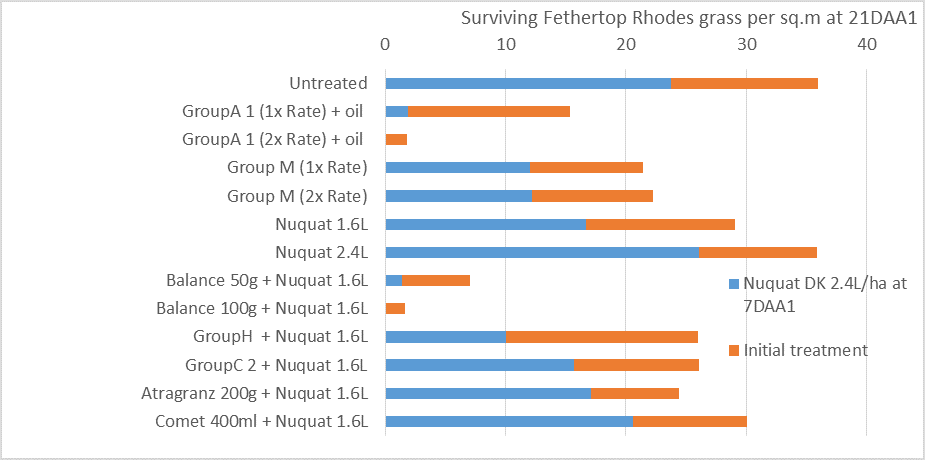
Figure 4: Control of Feathertop Rhodes grass seedlings, Crooble 2014 (Source: NGA).

Figure 5: Percentage reduction in FTR / sq m, initial population tillering @ 8-10 / sq m, Moree January 2013 (Source: NGA).
Pre-emergent residual herbicides in fallow
Balance® (Isoxaflutole) is registered for pre-emergent fallow control of FTR in all states at 100g/ha. Balance® has shown to be very effective (Figure 6).
Flame is only registered for fallowsɸ.
ɸFTR no on label.
Dual Gold (Metolachlor), Stomp (Pendimethalin) and Terbyne (Terbuthylazine) have registrations for grass control in a number of summer crops, but not all are registered for use as a fallow residual herbicide. Check relevant label for recommendations.
Be aware of the plant back intervals. Residual herbicides have different mechanisms of breakdown. Rainfall and soil features such as pH, organic carbon (OC), microbial capacity often interact to drive the speed of that breakdown. Certain products can last a very long time on some soils in the central west with very low pH (< 4.8 CaCl²) and low OC (<1%) (B Haskins pers comm). Growers need to understand those mechanisms and seek professional advice from experienced advisers before implementing a residual program.
Low summer rainfall can extend the plant back interval.
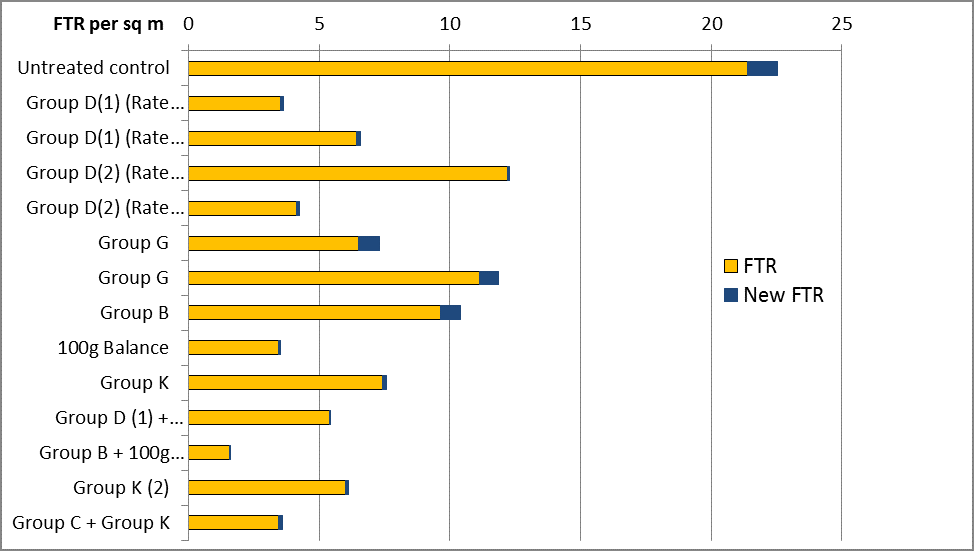
Figure 6: Effect of pre-emergent residual herbicides on FTR population (per square metre) plus the effect on subsequent seedling emergence 39DAT: Source NGA, Crooble 2013-14.
Pre emergent residual herbicides in winter crop
NGA ran a series of trialsɸ in 2012 to analyse the residual activity of a number of registered winter products. Results were inconsistent but some key points were noted:
If growing Wheat: Trifluralin, Sakura and Sakura + Chlorsulfuron offered the most consistent residual control of FTR. Boxer Gold was useful.
If growing chickpeas; Balance had very good residual efficacy on FTR. Simazine alone was ineffective.
Terbyne (Terbuthylazine) is registered in a number of winter crops including chickpeas, faba beans, lentils and TT canola and offered moderate levels of control.
Growers should seek advice regarding the breakdown mechanism of residual herbicides for their particular circumstance.
ɸAs specified, these are trial results, growers need to check label recommendations for the registered commercial use of these products.
WeedSeeker and WeediT sprayers
These weed targeting sprayers provide an opportunity to control scattered new weeds or escaped survivors. Often they are used as a secondary or tertiary method of control, after the background of ‘easy to kill’ weeds have been removed. They are being used successfully with heavy knockdown rates, and with Paraquat + residuals. It would be a technological breakthrough if a prescription map could be created based on previous populations and then subsequently used to apply residual herbicides only to those targeted sites.
Non herbicide control options
Cultivation
Cultivation (aka strategic tillage) is a very effective tool, but growers have vast differences in opinion as to where and when they use it. There are paddocks that have not been tilled for 25 years and those growers will use all other strategies before they disturb the soil. Also be aware of the long term impact on other weeds with regards to prolonging the seed viability for harder seeded species such as annual ryegrass and wild radish.
Depth of cultivation is important when considering FTR seed burial.
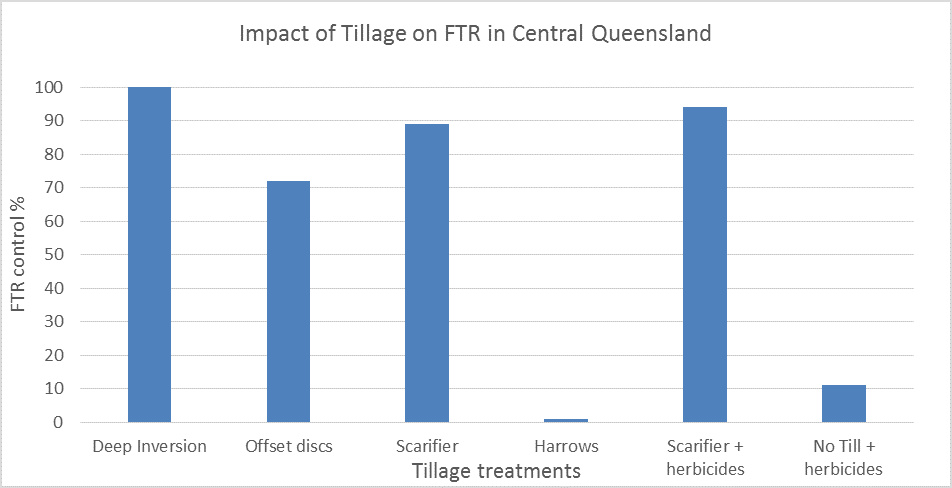
Figure 7: Impact of different tillage types, some with residual herbicides included, on the control of FTR at 9 months after application after receiving >200mm rain.(Source: Northern IWM fact sheet: Feathertop Rhodes grass - A weed best management guide).
Chipping or hand-hoeing
This labour intensive exercise to manually remove scattered isolated plants or small FTR clumps is very worthwhile. Don’t ignore single plants, from little things – big things grow. Monitor for escapes and control them. Micro-manage on a macro scale. This is an important component of a successful IWM program.
Burning
Burning is a useful option to reduce the seed burden from mature plants and/or escapes, preferably when they are in small patches.
Technology
Research by University of Sydney’s Centre for Field Robotics and Queensland University of Technology is underway to utilise herbicide and non-herbicide measures using unmanned robotic vehicles. The non herbicide components could include cultivation, microwave and steam. Currently a GRDC funded project is looking at developing a ‘targeted tillage’ implement for use in low density weed populations. The concept combines weed seeker technology with a tined implement.
Where are we up to with IWM?
To date most growers and advisers have mainly fought herbicide resistance with other herbicides. In northern NSW the trend has been to replace straight glyphosate with glyphosate + Group A, and usually adding a paraquat double knock. The current step is to strategically add residuals into the system. But are we winning? Other tactics need to be engaged, firstly to achieve better results on the weeds, but equally importantly, to protect the viability of the current herbicides.
The list of IWM options include: glyphosate (not registered), Group A’s (not many are registered), Group L herbicides (e.g. Paraquat), early timing camera sprayers – WeedSeeker or WeediT, residual herbicides in fallow, residual herbicides in the previous winter crop, cultivation (strategic tillage), chipping (hand-hoeing), crop competition and crop rotation, burning, technology – robotic swarms with targeted herbicides, microwave and steam.
Successful IWM is all about finding the most cost-effective combination of the list. The weaknesses in the ecology of FTR are its short seed life and poor emergence from depth.
Roadsides, fencelines and non-cropped areas should be managed to avoid any outbreaks, otherwise they will be a constant source of wind-blown seed.
Conclusion
If your current farming system and methods of control is leading to blowouts in certain ‘hard to kill’ weeds such as FTR, then change it. FTR is a symptom of our systems having become over-reliant on glyphosate. Do the research, giving full consideration of other weeds such as annual ryegrass and wild radish, then devise a management plan with your adviser that suits your preferred crop types, climate, soil, and budget. Don’t be afraid to make a mistake, but make sure you don’t make the same mistake twice.
Useful resources
GRDC – Update papers 2011, Problem weeds – latest research and control strategies for Feathertop Rhodes grass, fleabane and herbicide resistance. Michael Widderick (DEEDI), Vikki Osten (DEEDI), Richard Daniel (NGA)
http://grdc.com.au/Resources/Factsheets/2014/Integrated Weed Management of Feathertop Rhodes Grass. Compiled by Darren Aisthorpe, CQ Grower Solutions, Agri-Science QLD, Dept Agriculture, Fisheries and Forestry.
Northern IWM fact sheet: Feathertop Rhodes grass - A weed best management guide. Prepared by Vikki Osten QLD DAFF, Michael Widderick QLD DAFF, Tony Cook NSW DPI, Steve Walker OQ, Lawrie Price NGA, Graham Spackman CQGS
WEEDpak. Managing Feathertop Rhodes grass in Cotton. Jeff Werth, Vikki Osten, Michael Widderick, Steve Walker (DAFF, QAFFI), November 2013
Northern Grower Alliance website. Results and Publications. Richard Daniel & Lawrie Price, pers comm.
Barry Haskins, Consultant, Ag Grow Agronomy and Research Pty Ltd, pers comm.
Contact details
Rob LongB&W Rural Moree
0428 971751
robert.long@elders.com.au
@longwharff, @BWRural, @NthGwrAlliance
Was this page helpful?
YOUR FEEDBACK
